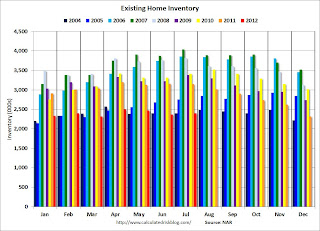by Calculated Risk on 8/22/2012 11:42:00 AM
Wednesday, August 22, 2012
Existing Home Sales: Inventory and NSA Sales Graph
The NAR had some issues with the report this morning. Here is the press release: Existing-Home Sales Improve in July, Prices Continue to Rise
Total existing-home sales, which are completed transactions that include single-family homes, townhomes, condominiums and co-ops, grew 2.3 percent to a seasonally adjusted annual rate of 4.47 million in July from 4.37 million in June, and are 10.4 percent above the 4.05 million-unit pace in July 2011.Based on historical turnover rates, I think "normal" sales would be in the 4.5 to 5.0 million range. So existing home sales are close to "normal" now, however, of course, "normal" would have very few distressed sales - so in that sense the market is a long ways from "normal". But no one should expect existing home sales to go back to 6 or 7 million per year. Instead the key to returning to "normal" is more conventional sales and fewer distressed sales.
...
Total housing inventory at the end July increased 1.3 percent to 2.40 million existing homes available for sale, which represents a 6.4-month supply at the current sales pace, down from a 6.5-month supply in June. Listed inventory is 23.8 percent below a year ago when there was a 9.3-month supply.
...
Distressed homes – foreclosures and short sales sold at deep discounts – accounted for 24 percent of July sales (12 percent were foreclosures and 12 percent were short sales), down from 25 percent in June and 29 percent in July 2011.
...
Given population and demographic demand, [Lawrence Yun, NAR chief economist] said existing-home sales could be in a normal range of 5 to 5.5 million if all conditions were optimal. “Sales may reach 5 million next year, but it will require more sensible lending standards and stronger job creation to push beyond that,” he said.
As I've noted before, what matters the most in the NAR's existing home sales report is inventory; and what matters the most in the new home sales report tomorrow is sales. It is active inventory that impacts prices (although the "shadow" inventory will keep prices from rising). Those looking at the number of existing home sales for a recovery in housing are looking at the wrong number. For existing home sales, look at inventory first and then at the percent of conventional sales.
The NAR reported inventory increased to 2.40 million units in July, up slightly from June. This is down 23.8% from July 2011, and down 13% from the inventory level in July 2005 (mid-2005 was when inventory started increasing sharply). This is the same level for inventory as in July 2004.
Clearly inventory will be below the comparable month in 2005 for the rest of the year and will probably track close to the level in 2004. It looks like inventory peaked this year in April.
Important: The NAR reports active listings, and although there is some variability across the country in what is considered active, most "contingent short sales" are not included. "Contingent short sales" are strange listings since the listings were frequently NEVER on the market (they were listed as contingent), and they hang around for a long time - they are probably more closely related to shadow inventory than active inventory. However when we compare inventory to 2005, we need to remember there were no "short sale contingent" listings in 2005. In the areas I track, the number of "short sale contingent" listings is also down sharply year-over-year.
The following graph shows inventory by month since 2004. In 2005 (dark blue columns), inventory kept rising all year - and that was a clear sign that the housing bubble was ending.
 Click on graph for larger image.
Click on graph for larger image.This year (dark red for 2012) inventory is at the lowest level for the month of July since 2004, and inventory is below the level in July 2005 (not counting contingent sales). However inventory is still elevated using months-of-supply, but I expect months-of-supply to be below 6 later this year.
The following graph shows existing home sales Not Seasonally Adjusted (NSA).
 Sales NSA (red column) are above the sales for 2008, 2010 and 2011. Sales are well below the bubble years of 2005 and 2006.
Sales NSA (red column) are above the sales for 2008, 2010 and 2011. Sales are well below the bubble years of 2005 and 2006.Earlier:
• Existing Home Sales in July: 4.47 million SAAR, 6.4 months of supply99
• Existing Home Sales graphs


